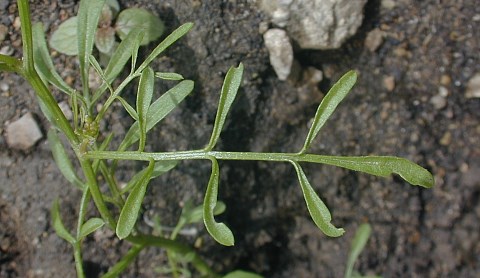Description: This plant is a winter annual that becomes ½–1¼' tall. Initially, it produces a few odd-pinnate basal leaves, but these wither away prior to the blooming period. The central stem is erect to weakly ascending, branching occasionally to produce secondary stems. These stems are light to medium green, slightly angular, and glabrous; however, the lowest portion of the central stem may be purple-green. The cauline leaves alternate along the stems; like the basal leaves, they are odd-pinnate with about 5-9 leaflets.

The leaflets of
the middle to upper cauline leaves are linear, linear-oblong, or
narrowly oblanceolate in shape and about 1/8" (3 mm.) across; the
leaflets of
the basal leaves and lower cauline leaves have similar shapes, but they
are slightly wider. Usually, the terminal leaflets are no wider than
the lateral leaflets. However, on basal leaves and lower cauline
leaves, the terminal leaflets are sometimes wider than the lateral
leaflets and more obovate in shape. All of these leaflets are medium
green and glabrous; their margins are usually smooth, but occasionally
the wider terminal leaflets have margins that undulate or are slightly
lobed. The upper stems terminate in racemes of flowers. The flowers
bloom toward the apex of each raceme, while the siliques
(cylindrical
seedpods) develop below. Each small flower is about 1/8" (3 mm.)
across,
consisting of 4 white petals, 4 lanceolate sepals, a pistil with a
short stout style, and several stamens. The pedicels of the flowers
(and siliques) are about 1/3" (8 mm.) long and ascending. The blooming
period
occurs from mid-spring to mid-summer and lasts about 2 months. Each
flower is replaced by an ascending silique that is about ¾–1¼" long;
these siliques are straight to slightly curved and glabrous. At
maturity, each silique splits open lengthwise to release several tiny
seeds. Individual seeds are about 1 mm. long, ovoid in shape, and
somewhat flattened; their margins are not winged. The root system is
shallow and fibrous. This plant reproduces by reseeding itself.
Cultivation:
The preference is full sun to light shade and moist to dry conditions.
This plant adapts readily to many kinds of soil, including those that
contain fertile loam, sand, or rocky material. Most growth and
development occurs during the spring and early summer.
Range & Habitat:
Small-Flowered Bitter Cress is occasional in the southern half of
Illinois and NE Illinois, while in other parts of the state it is
uncommon or absent. The typical variety of this species is native to
Eurasia, while the variety that is described here is native to North
America. Habitats include upland woodlands, thinly wooded bluffs, rocky
glades, damp depressions along sandstone cliffs, flower beds and
vegetable gardens, construction sites in urban areas, and agricultural
fields. This little plant can be found in both natural areas and highly
disturbed habitats where competing ground vegetation is sparse.
Faunal Associations:
The flowers are probably visited by small bees and flies seeking nectar
or pollen. The butterfly Anthocharis midea (Falcate
Orangetip) and the moth Evergestis pallidata
(Purple-Backed Cabbageworm) occasionally select Cardamine spp.
(Bitter Cress species) as food plants for their caterpillars.
Photographic Location:
A flower bed at the Urbana Public Library in Urbana, Illinois.

Comments: Small-Flowered Bitter Cress is a native plant in the Mustard family that has managed to spread into some human-created habitats in both rural and urban areas. It tends to be less aggressive than some of the more common weeds from Eurasia. Other plants that are similar in appearance to this species include Cardamine pensylvanica (Pennsylvania Bitter Cress) and Cardamine hirsuta (Hairy Bitter Cress). Pennsylvania Bitter Cress is larger plant with wider leaflets (at least ¼" across) and its terminal leaflets are usually wider than the lateral leaflets. Small-Flowered Bitter Cress has leaflets that are less than ¼" across and its terminal leaflets are usually no wider than the lateral leaflets. Hairy Bitter Cress, which is introduced from Eurasia, has primarily basal leaves that persist through the flowering period and the base of its central stem is usually hairy; like Pennsylvania Bitter Cress, this species has wider leaflets than Small-Flowered Bitter Cress. All of these species differ from the similar Arabis spp. (Rock Cress species) by their seeds; Rock Cress species have seeds with winged margins, while the seeds of Bitter Cress species lack such margins.